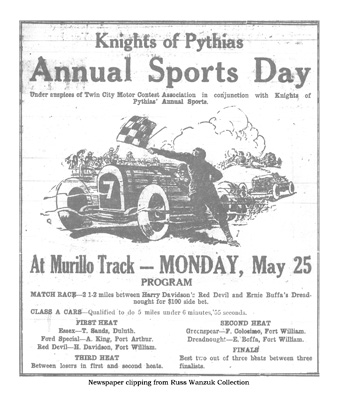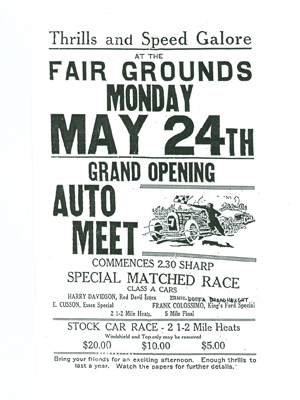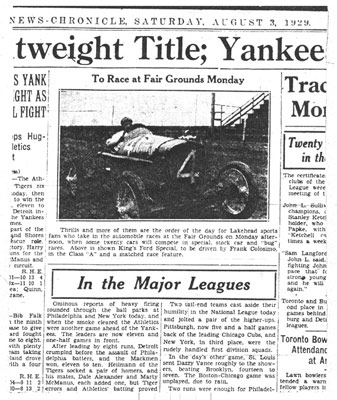
Resurrection of a King
Part II: Early History of the King's Special
When the King brothers finally had their racing machine ready for a public showing, it was Art King who chose to pilot the car for the first time, during the time trials at the Murillo fair grounds. Whereas the fans of the family's new race car were expecting Art and the 'King's Special Ford' being crowned, 'King of the Track,' figuratively speaking, King (the driver) came very close to losing his 'crown'. . . literally!
As The News-Chronicle (May 18, 1925) reported:
TURNS TURTLE IN SPEED TRIALS AT MURILLO TRACK Driver is Unhurt and Will be in Shape For Next Monday's Events
Art King, owner of the revolutionized Ford speed wagon which is expected to carry Port Arthur colors in the Class A competition this year, qualified in somewhat unusual fashion on the Murillo track Saturday afternoon. King had warmed his engine up with two trial trips around the speedway and started the third at terrific speed. He made remarkable time for the first portion of the lap, but on a dangerous curve he took to the ditch, where his car rolled over at least twice. It was a case of too much speed on the corner, due to over anxiety to qualify. The car carried every possible safety appliance and when King was released he was found to be practically uninjured. A cut on the back of the head and body bruises were the extent of the injuries. But the judges unanimously agree that King showed sufficient speed to qualify for Class A competition. All that Art has to do now is put his speedster in A1 condition for the big races on May 25. In addition to the four local cars which are expected to take place in the auto events, negotiations are being carried on with the drivers of two fast Duluth teams.
The other newspaper referred to the same incident:
While driving his auto at a speed of nearly sixty miles an hour in a Twin City Motor Contest association test on the Murillo speedway . . . . . . Arthur King was hurled from his seat when the car leaped the embankment, hit a culvert and turned a complete somersault landing again on its wheels. King, miraculously, was injured only slightly . . . . . .

The brothers were obviously able to get the car running again for the big event the following week, as the News Chronicle (May 26, 1925) summarized:
SPEED DEMONS TOSS THE DIRT ON MURILLO TRACK Art King's Ford Special looked to many one of the best speed boats seen on local tracks in many moons but Horace King, who drove in place of his brother whose shoulder is still stiff from his tumble while qualifying, is not an experienced driver on a race track. He showed considerable grit in matching pace with his formidable rivals.
This may have been the only official race in which Horace took part, for in August of that same season, the car was piloted once again by Art. The car seemed powerful enough, but the results of the race were not in the Kings' favour (TJ, Aug. 10, 1925):
Boffa Sets New Record For Two and Half Miles Local Speed Driver Puts Dreadnought Over Route in Better Than 50 Miles an Hour Breaking the track record for 2 ½ miles Saturday afternoon at the fair grounds. . . Ernie Boffa at the wheel of the Dreadnought (16 Valve Dodge) drove sensational races to win the day in establishing a new record of 2 minutes and 57 seconds. . . . Boffa gave a remarkable daring and clever exhibition on a track, still soft from recent repairs and rains. The former skyline for the distance, 3 minutes and 6 seconds was also held by Boffa, who twice before clipped that mark, once in his own high-powered machine and once driving Arthur King's natty special Ford.
Further along in the same article, the press mentions that Arthur's efforts to pilot his car to victory were not enough:
Colosimo A Winner Colosimo, for many meets past a loser, came to bat in the opening event on the program with a victory over King's special Ford. On the straightaways, the Greenspear, one time unbeatable Colosimo special was not in it with the Ford, whose pilot, Arthur King, racing for the first time since his accident at Murillo. . . . slowing for the corner to keep his light wagon, skidding freely on the turns, upright. . . . .He (Colosimo) finished winner by a scant two lengths, after his engine almost died on him drawing to the wire.
When the racing season opened in the spring of 1926, fans would have been surprised at the new line-up. A poster advertising the May 24th races listed the Class A cars and their drivers. As expected, there was the Dodge-powered "Dreadnaught" driven by Ernie Boffa; there were two Essexes, one driven by Ed Cusson (who later provided many details about the King's Special for this document); lastly, there was the King's Special, but not with Arthur King as driver. Frank Colosimo was now in his place. From this point on, the fastest car was to be driven by a most aggressive and fan-loving driver. The stage was set for some spectacular races.

A neat description of the King's Special's greatest adversary, the Dreadnaught, appears in the builder's (and driver's) own words (Canadian Bush Pilot Ernie Boffa, by Florence Whyard, Alaska Northwest Pub. Co., 1984), Ernie Boffa explains:
I started with a Model-T frame, all underslung, very light. Then put in a Dodge steering gear - - it was stouter, you know - - and an old Dodge 4 engine, with counterbalance crankshaft pressure, overhead 16 valve, Miller carburetor and magneto and what have you. Boy! Was that ever good! That thing was like a motorcycle. When you stepped on it, she'd snap your head back
During the next few years, Colosimo and the King's Special became an "unbeatable combo". From 1925 to 1932, it lost very few races, according to the Times Journal (Sept. 25, 1957), not bad when you consider the speeds were climbing each year and competition was stiffer. A world-class racer on the best half-mile dirt track could achieve little more than a 60 mph average; our local fellows were approaching that speed on tracks that had no banked corners and were far from optimum. Besides rocks, fences, posts, culverts, etc. that are mentioned in various accounts, the inter-city track had the McIntyre River running along one end of it, so you definitely didn't want to miss the first turn! (see footnote).

Of all the races between 1926 and '29, the one that produced the most sensational headlines was the Labour Day race of the latter year. Both newpapers headlined the event; here is the Times Journal's report ( Sept.3, 1929):
It appeared as though tragedy stalked among the huge crowd of pleasure-seekers. A wave of humanity swept toward the up-turned machine and its apparently ill-fated occupant. Luckily the belt by which Colosimo was strapped in his seat severed with the jolt and he sustained but a slightly bruised shoulder. The car, however, suffered considerable damage. The spill occurred following one of the greatest get-aways ever seen on the local track. Both Colosimo and Boffa exhibited a daring that shortened the breath and set the pulses racing. Colosimo took the lead at the first turn when Boffa skimmed the outer edge perilously. Boffa, by skillful driving, gained the pole at the same turn at the beginning of the second lap. It was at the lower turn that Colosimo's machine turned over. Attempting to regain his lost ground Colosimo made to pass the Dreadnaught, his right rear wheel going over the edge as the cloud of dust almost hid him from sight. In trying to get back on the track he wheeled too sharply and the Ford upset twice, not, however, before throwing the driver well clear. Later Colosimo appeared on the track. A broken steering wheel and twisted frame was the visible damage to his car. Both the St. John Ambulance man who administered first aid and Dr. J.C.Cook who examined him shortly afterwards, stated no bones were broken. (A later article mentioned that the driver suffered four broken ribs).
Colosimo Thrown 25 Feet in Air As Car Turns Turtle Nearly 4,000 View Spill In Big Race At Turn On Lap 2 The hearts of almost 4,000 fans were chilled for a moment during the most thrilling race of yesterday's automobile speed contests at the Fair Grounds. When (A)rnie King's Baby Ford special turned turtle and threw its driver, Frank Colosimo fully twenty-five feet in the air in the matched race with Ernie Boffa, driving the renowned Dreadnaught.
Despite his injuries, Frank Colosimo was to compete in many more races, but his body probably healed up long before the King's Special was track-worthy again. A picture of the car shown in August, about a month before the fateful race, shows a Model T chassis with a regular Model T radiator and hood, and what appears like a very small tail section. The wheels are wire, but have the characteristic wide hubs that proved to be more durable on the dirt tracks than wire wheels built for passenger car use. Mechanical shock absorbers can also be seen in the picture. The exhaust system appears as a large header running along the right side of the car. During the winter of 1929, the body had a complete make-over. When the racer hit the track in the summer of 1930, it had morphed into such a phenomenal vehicle that it no longer needed a number to set it off from the others. It was unique, but truly a magnificent machine, and the Press loved it!
Note: Our research suggests that what had been the first turn before 1934 became the third turn after that date. Bill Kelso, who was in his nineties when this author interviewed him, claimed that the entrance to the track was from the Fort William Road early on, and the grandstand was on that same side. Later, the Fair Grounds purchased a strip of land along Memorial Avenue, and the entrance was then opened from that street. He said that potatoes were planted in that strip during the '20's and early '30's. One of the large buildings seen in the early film footage still exists, but at its more recent location on the Memorial Avenue side of the track. It is now referred to as the 'Dorothy Dove Building' and has been used as a market site.)